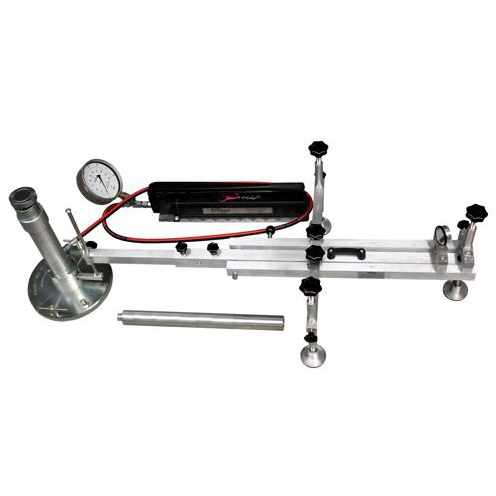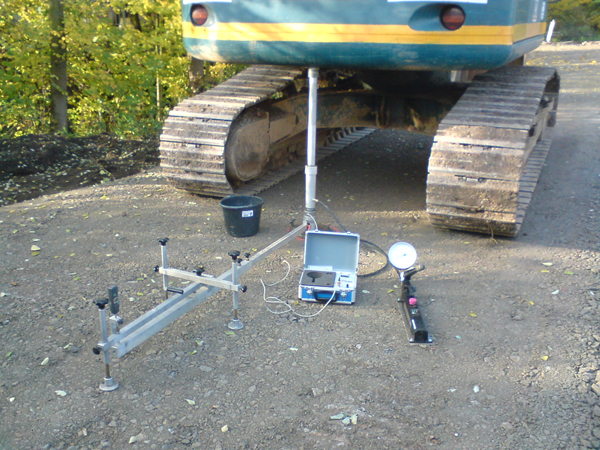Plate Load Test
SIA “Ģeo Eksperts”
offers to perform plate load tests (static
plate) with a standard plate Ø 300 mm. Plate Bearing Test Equipment
100 kN acc. to DIN 18134 with 22.9 cm² cylinder
of the German manufacturer Fröwag GmbH is used for the plate tests.

The device consists of:
- Single-gauge measuring bridge with telescopic measuring beam and
adjustable supports;
- Precision dial gauge 30 x 0,01 mm;
- Hydraulic system 100 kN with hydraulic jack, lifting 150mm,
pressure tube 2 m, hydraulic pump with pressure gauge ø 160 mm with triple
scale for plate ø 300 mm, 600 mm and 762 mm;
- Upper pressure plate with magnet and ball joint;
- Bearing plate ø 300 mm with measuring tunnel, adapter for
electronic load transducer and adjustable bubble level;
- Set of pluggable extensions rods 530 mm;
- Total system weight with 2 carrying cases: 69 kg.
General information about the
method
The plate load test (designation in Eurocode 7 – PLT)
is used to assess the deformation
properties of the soil, as well as the quality of the compaction works
performed on shallow foundations. This test can be performed on all types of
dispersed (loose) soils, embankments and crushed stone layers, but is generally
not used in very soft and fine-grained soils. Testing of shallow foundation with
a plate must be performed on a flat and smooth surface -
either on the surface of the ground or at the foundation of the excavation at a
certain depth. If the construction design specifies requirements for the
bearing capacity or compaction of the prepared soil layer (ledge), the static plate
method is considered to be one of the most accurate methods for determining
this load-bearing capacity and compaction
degree.
It should be noted that with a standard stamp of Ø 300 mm the soil is
tested at a depth of about 60 cm (x2
stamp diameter). Therefore, in cases where a compaction test of a thicker
embankment layer is required, the tests should be carried out gradually when
the corresponding embankment layer is heaped up and compacted.
Preparing for the test
The stamp is intended to be installed on the surface
of the soil to be investigated. In order to achieve close contact of the base
of the stamp with the soil, it is necessary to make not less than two rotations
of the stamp around its vertical axis while changing the direction of rotation.
After installing the stamp, it is necessary to check its vertical position (so
that it is not tilted). The soil surface must be carefully levelled within the
installation area of the stamp. If there are difficulties with levelling the
soil surface, you can create a "bed" of fine or medium dry sand a few
millimetres thick.
After installing the stamp, the support stand, the
loading bridge, the hydraulic jack and the measuring system are installed. The
height of the support rack must be adjusted in such a way that the upper-pressure plate would be based on a flat
counterweight element. As a counterweight, any heavy-duty vehicle or road and construction
machinery with sufficient mass may be used. Before starting the measurement, it
is necessary to check whether the device is in a completely vertical position
and make sure that the counterweight is secured properly.
Performing the test
Plate load test is performed based on German standard
DIN 18134 (Testing procedures and testing equipment – Plate-loading test).
The loading of the stamp must be carried out with a
gradual increase in pressure. The pressure recommended by DIN 18134 for the
standard stamp of Ø 300 mm, which must be achieved by loading, is 0.5 MN/m2
(or 0.5 MPa). The load shall be increased in not less than six stages or steps approximately
of the same degree until the
aforementioned maximum pressure is reached. Each change of load (from step to
step) must be completed within one minute. The loading test consists of three
stages – the first-time loading when a pressure of 0.5 MN/m2 is
reached with at least 6 loading steps; unload (3 pressure reduction stages
(50%, 25% and ~ 2% of maximum load)); followed by a second-time loading, during
which the load must be increased to the pre-final load level of the first cycle
(so that a full load of 0.5 MPa would not be achieved).
All parameters to be measured (load on the stamp, corresponding compaction, loading degree
number, etc.) are entered manually in the special field log.
Processing of results
After performing the test at the site, the data
obtained are processed and the results are evaluated in the office. Based on
the recommendations given in DIN 18134, calculations can be done manually
based on the calculation formulas provided by this standard, but can also be
done using special computer software designed for this purpose. SIA “Geo Eksperts” uses the ProPlatt software developed by German company “HMP Magdeburger
Prüfgerätebau GmbH” for the processing of the static plate data. As a result of
the static plate-loading test, the following main parameters are obtained: EV1
(after first-time loading results)
and EV2 (after second-time
loading results) deformation modules as well as the ratio of these modules
EV2/EV1. In the construction practice, the value EV2
and the ratio EV2/EV1 are mainly used. The value EV2
shows the bearing capacity and deformation properties of the tested soil, but
the ratio EV2/EV1 indicates the degree of compaction of
the particular soil type.
Important!
In order to perform the plate test, the Customer must ensure the existence of an appropriate counterweight on the site at its own expense
(heavy construction machinery or
vehicle).

